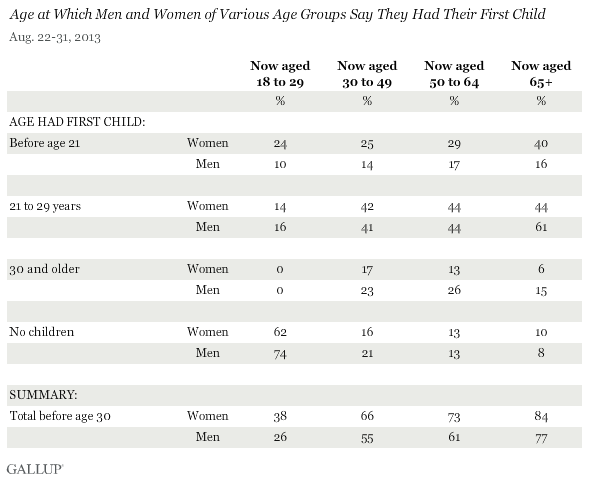PRINCETON, NJ -- Young American women are more likely than young men to be parents, and to have their first child earlier. Twenty-four percent of adult women younger than 30 in the U.S. say they had their first child before they turned 21, compared with 10% of men. And 38% of 18- to 29-year-old females currently have a child, while 26% of men in the same age group do.

These findings are from on an Aug. 22-31 Gallup survey, in which 5,100 national adults were asked a number of questions about their experiences and desires with regard to having children. The study includes 3,899 adults who have had a child at some point in their life. In the same study, Americans, on average, favored 25 as the ideal age for a woman to have a child and 27 as the ideal age for men.
The percentages of men and women aged 18 to 29 who say they are already parents is low relative to adults aged 30 and older who had a child before 30. This is at least in part because many younger adults have a number of years remaining before they turn 30.
Nevertheless, a societal shift toward delaying parenthood is clearly evident in the rates of 30- to 49-year-old women and men who say they had their first child before age 30. Women in this age group (66%) are less likely to say they had their first child before age 30 than women aged 50 to 64 (73%) and 65 and older (84%). Similarly, men aged 30 to 49 (55%) are less likely to have had their first child before 30 than men aged 50 to 64 (61%), and those 65 and older (77%).
One in Four Women Still Becomes a Mother Before Turning 21
Additionally, the proportion of women having their first child prior to turning 21 has clearly declined in recent decades. Forty percent of women 65 and older say they had their first child before age 21, while the rate is below 30% for all women in younger age groups: 29% among those 50 to 64; 25% among those 30 to 49; and 24% among those 18 to 29.
Gender Gap Widens for Young Parenthood
While the percentages of men and women having children before age 30 have declined in the U.S., the gender gap in having a child before 30 has not narrowed, and in fact is wider today than it was for older generations.
More specifically, nearly 1 ½ times as many women as men aged 18 to 29 have a child, 38% vs. 26%. By contrast, women in the middle-aged groups (aged 30 to 49 and 50 to 64) are only slightly more likely to have had a child before age 30 than men of the same age range, while the gender gap on this nearly disappears among seniors.
Complete data by age for this measure are found on page 2.
Implications
Although men and women are waiting longer, on average, to have a child than their parents and grandparents may have, Gallup finds that most of those who haven't had children still hope to someday. The appeal of parenthood remains strong. However, the responsibilities involved in raising a child have major financial and lifestyle implications. Thus, any differences between men and women in how early each starts having children can affect the trajectory of their lives in profound ways -- some positive, but some also challenging.
Future Gallup research will examine the socioeconomic status of men and women who had their first child earlier rather than later, including their marital status, household income, and formal education.
Survey Methods
Results for this Gallup poll are based on telephone interviews conducted Aug. 22-31, 2013, with a random sample of 5,100 adults, aged 18 and older, living in all 50 U.S. states and the District of Columbia.
For results based on the total sample of national adults, one can say with 95% confidence that the margin of sampling error is ±2 percentage points.
For results based on the sample of 3,899 parents, the maximum margin of sampling error is ±2 percentage points.
Interviews are conducted with respondents on landline telephones and cellular phones, with interviews conducted in Spanish for respondents who are primarily Spanish-speaking. Each sample of national adults includes a minimum quota of 50% cellphone respondents and 50% landline respondents, with additional minimum quotas by region. Landline and cell telephone numbers are selected using random-digit-dial methods. Landline respondents are chosen at random within each household on the basis of which member had the most recent birthday.
Samples are weighted to correct for unequal selection probability, nonresponse, and double coverage of landline and cell users in the two sampling frames. They are also weighted to match the national demographics of gender, age, race, Hispanic ethnicity, education, region, population density, and phone status (cellphone only/landline only/both, and cellphone mostly). Demographic weighting targets are based on the March 2012 Current Population Survey figures for the aged 18 and older U.S. population. Phone status targets are based on the July-December 2011 National Health Interview Survey. Population density targets are based on the 2010 census. All reported margins of sampling error include the computed design effects for weighting.
In addition to sampling error, question wording and practical difficulties in conducting surveys can introduce error or bias into the findings of public opinion polls.
View methodology, full question results, and trend data.
For more details on Gallup's polling methodology, visit www.gallup.com.

